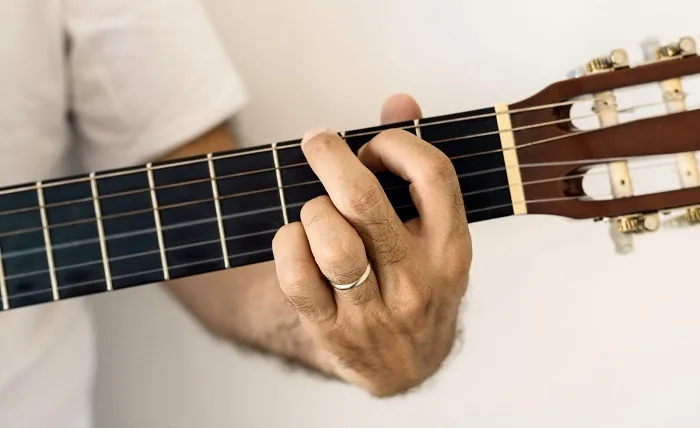The guitar is a versatile and widely popular musical instrument that has captivated generations of musicians. One of the fundamental aspects of playing the guitar is understanding chords. Chords are combinations of notes played together to create harmony and enrich the sound of the guitar. They serve as the building blocks for countless songs across various genres. In this article, we will explore the fascinating world of guitar chords and delve into the question: “How many chords are there on guitar?”
The guitar is renowned for its ability to create rich and melodious sounds through the use of chords. Learning and mastering chords is a crucial step for any guitarist, whether you’re a beginner or an experienced player. With a multitude of chord variations available, the possibilities for musical expression are virtually endless.
If you want to learn how to play guitar easily study this article – easy b7 chord.
What are Chords?
Chords are formed by playing multiple notes simultaneously, producing a harmonious blend of sound. On the guitar, chords are typically constructed using a combination of open strings (unfretted) and fretted notes. By pressing down on specific frets and strumming the strings, guitarists can create a wide range of chord voicings and tones.
Understanding Chord Structure
Chords are composed of three or more notes that are played together. The notes used in a chord are derived from a particular scale or key. The most common chords are triads, which consist of a root note, a third interval, and a fifth interval. For example, a C major chord comprises the notes C, E, and G.
Basic Guitar Chords
Open Chords
Open chords are the foundation for many popular songs. They are played using a combination of open strings and fretted notes near the headstock of the guitar. Some commonly used open chords include C, G, D, A, E, and F.
Barre Chords
Barre chords are moveable chord shapes that allow guitarists to play the same chord in different positions on the neck. They require the use of a barre finger across multiple strings to create different chord voicings. Barre chords are essential for playing in different keys and expanding your chord vocabulary.
Intermediate and Advanced Chords
Power Chords
Power chords are popular in rock and metal genres. They are simple two-note chords consisting of the root note and the fifth interval. Power chords are often played with distortion or overdriven guitar tones to achieve a heavy and aggressive sound.
Suspended Chords
Suspended chords, commonly denoted as sus chords, add an element of tension and release to music. They replace the third interval of a triad with either a second or a fourth, creating a unique and expressive sound. Some popular suspended chords include Csus2 and Dsus4.
Extended Chords
Extended chords expand on the basic triads by adding additional intervals, such as the seventh, ninth, eleventh, or thirteenth. These chords are frequently used in jazz, blues, and fusion genres to create complex and colorful harmonies.
Altered Chords
Altered chords introduce chromatic alterations to the basic triads, resulting in a more dissonant and tension-filled sound. They are commonly found in jazz and modern music, adding a unique flavor to chord progressions.
Jazz Chords
Jazz chords are known for their complexity and richness. They often incorporate extended intervals, altered tones, and intricate voicings. Learning jazz chords can significantly enhance your improvisation skills and understanding of harmony.
The Role of Chords in Songwriting
Chords play a vital role in songwriting, providing the foundation and harmonic structure for melodies and lyrics. Understanding chord progressions and their emotional impact can help songwriters evoke specific moods and create captivating musical compositions.
Chord Progressions
Chord progressions are sequences of chords that form the backbone of a song. They establish the tonal center and guide the listener through different sections and harmonies. Common progressions include the I-IV-V progression, the 12-bar blues, and the ii-V-I progression.
Guitar Chord Resources
Learning and mastering guitar chords requires practice and dedication. Fortunately, numerous resources are available to assist you on your journey. Online tutorials, chord diagrams, chord books, and guitar apps can provide valuable guidance and help you expand your chord repertoire.
Conclusion
Guitar chords are a fundamental aspect of playing the guitar. With a vast array of chord variations and voicings, the number of chords available on the guitar is practically limitless. Whether you’re a beginner or an advanced player, exploring different chord types and progressions opens up a world of musical possibilities.
FAQs
How long does it take to learn guitar chords?
Learning guitar chords can vary from person to person. With consistent practice, beginners can start playing basic chords within a few weeks. Mastery of more complex chords and chord progressions may take several months or years of dedicated practice.
Can I play chords on an electric guitar?
Absolutely! Chords can be played on both acoustic and electric guitars. The technique and sound may differ slightly due to variations in guitar construction and amplification, but the fundamental principles of chord playing remain the same.
How many chords do I need to know to play most songs?
By learning a core set of open chords, barre chords, and power chords, you can play a vast majority of songs across different genres. Starting with common chords such as C, G, D, A, and E will give you a solid foundation to play many popular songs.
Are there any shortcuts to learning guitar chords?
While there are no shortcuts to mastery, some tips can expedite your chord learning journey. Breaking down chords into smaller fragments, practicing chord transitions, and using mnemonic devices can help you memorize and play chords more effectively.
Where can I find chord diagrams for guitar chords?
Chord diagrams can be found in guitar books, online tutorials, and guitar chord websites. These diagrams visually represent the finger positions on the fretboard, making it easier to learn and play chords.



